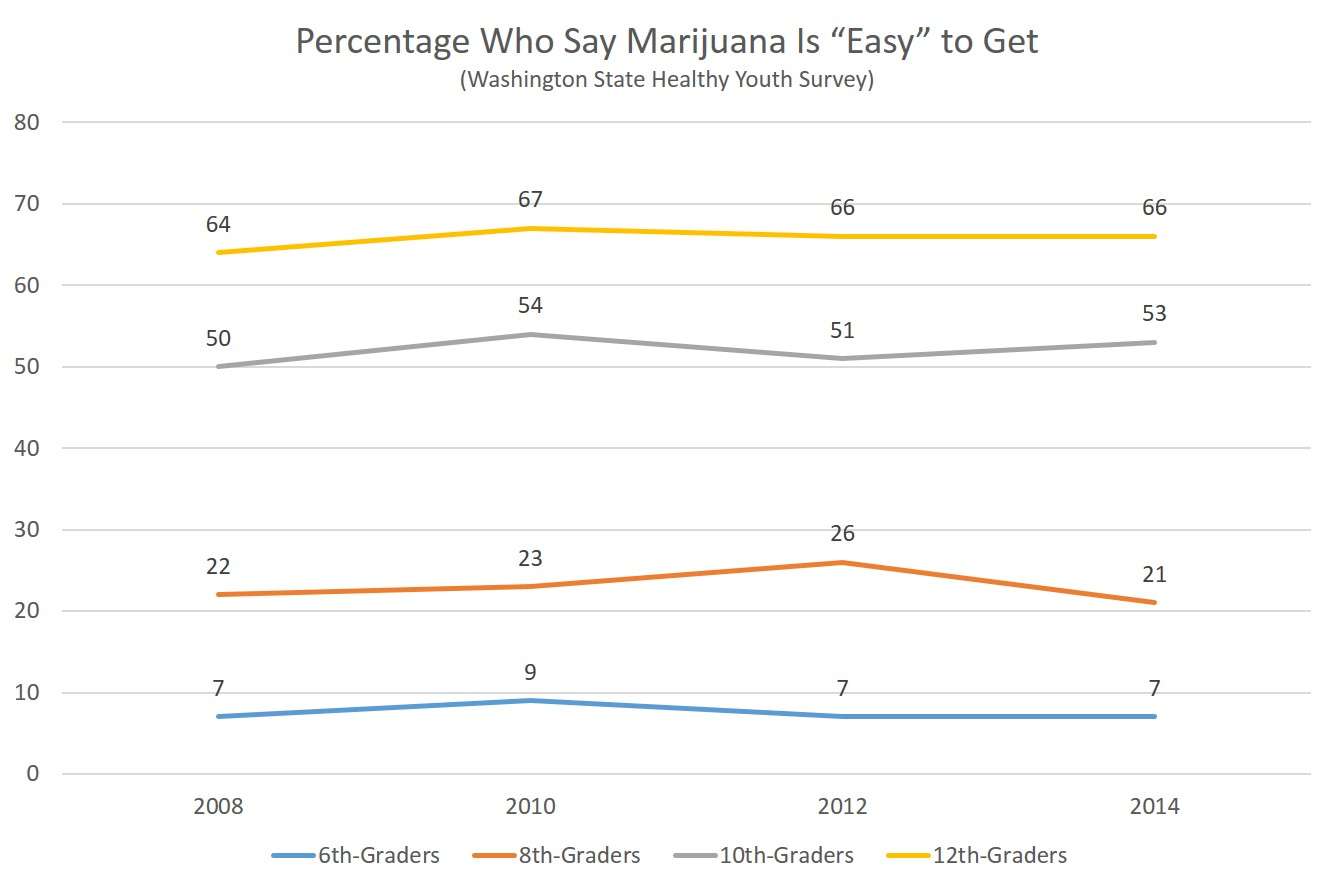Marijuana Legalization Did Not Initially Boost Underage Access in Washington
The percentage of students who say pot is easy to get shows little change in recent years.
Survey data from Washington indicate that legalizing marijuana for adults 21 or older in that state did not initially make it easier for teenagers to obtain the drug. But that finding should be interpreted with caution, since the most recent numbers come from 2014, the first year of legal recreational sales, which did not begin until the middle of the year.
According to the Washington State Healthy Youth Survey, which is conducted in even-numbered years, 66 percent of high school seniors said it would be "sort of easy" or "very easy" for them to obtain marijuana in 2014, the same as in 2012, when voters approved legalization. During the same period, that figure rose slightly for 10th-graders (from 51 percent to 53 percent), fell for eighth-graders (from 26 percent to 21 percent), and stayed the same (7 percent) for sixth-graders. Over all, reported ease of access has been essentially flat since 2008. The same survey indicates that past-month marijuana use stayed the same or fell slightly in all grades between 2012 and 2014.

An upcoming article in the Journal of Adolescent Health, previewed at a pediatric conference in Baltimore on Sunday, notes that the share of 10th-graders reporting "easy" access to marijuana was essentially the same in 2014 (53 percent) as in 2010 (54 percent). "It is both surprising and reassuring that teens didn't perceive that marijuana was easier to access after it was legalized for recreational use by adults," said one of the study's authors, New York pediatrician Andrew Adesman, in a press release from the American Academy of Pediatrics (AAP).
That AAP press release, headlined "Legalization of Marijuana in Washington State Shown to Have Had No Effect on Teens' Access to Drug," led to some reports that exaggerated the significance of the study's findings. According to High Times, Adesman and his colleagues say "legalization has no effect on teen pot smoking," while The Weed Blog reported that the researchers found "marijuana legalization does not make it easier for teens to get marijuana." Such conclusions are premature.
The 2014 survey was conducted in mid-October, just three and a half months after legal recreational sales began. Before then, recreational consumers were allowed to possess marijuana, but they had no legal way to obtain it, since Washington allows home cultivation only for medical use. Furthermore, the opening of state-licensed marijuana shops was a gradual process, with just a few operating initially. The 2016 survey, which will cover a period when more than 200 stores were operating and retail prices started to fall, will tell us more.
When it comes to the availability of marijuana to teenagers, two things can be expected to happen when legal merchants replace black-market dealers (something that has not happened yet in Washington, which still has a thriving black market, largely because taxes and regulations put licensed dealers at a competitive disadvantage). First, minors will have more difficulty buying marijuana directly from retailers, since legal merchants risk losing their licenses if they sell to customers younger than 21. Second, minors will have more opportunities to obtain marijuana indirectly from adult buyers, with or without the latter's consent. Which of these factors will have more of an impact on underage access and consumption remains an open question.
It may be significant that the percentage of Washington teenagers who said it was "hard" to get alcohol or cigarettes rose from 2010 to 2014 while no such trend was apparent for marijuana. Adesman called that contrast "interesting and somewhat concerning." It might indicate that "current public health efforts around drug abuse prevention may be less effective for marijuana than for other substances," as the AAP press release puts it. Then again, it may reflect the continuing role of a black market in which dealers do not card their customers.


Show Comments (39)